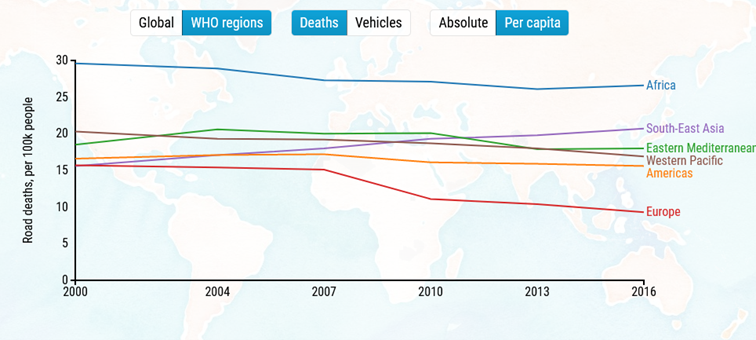Road Accident Statistics
“Approximately 1.35 million people die each year as a result of road traffic crashes.” Statistics such as this, taken from a factsheet on traffic injuries published by the World Health Organization, are difficult to put into context. A total of 1.35 million sounds like very little when compared to a global population of close to 8 billion, representing approximately only 0.02%. However, an accumulation of 1.35 million people would be considered a major city in most countries. Additionally, injuries from traffic accidents are the leading cause of death in children and young adults aged 5 to 29 years old.
This switch in perspective shows why the United Nations are addressing traffic safety as part of Sustainable Development Goal 3: Good Health and Well-Being. Sub-goal 3.6 sets the target of “halving the number of global deaths and injuries from road traffic accidents” by 2020 compared to the baseline year 2015. Running simultaneously, the WHO declared 2011-2020 the Decade of Action for Road Safety. Since we are now in 2021, let’s see how far we’ve come.
Road Deaths in 2020: Where do we stand?

Source: Death on the Roads by the World Health Organization.
Click here to directly access the interactive display.
The rate of traffic deaths has decreased slightly, from 18.7 per 100.000 in 2010 to 18.2 per 100.000 in 2016 (the most recent year for which global data is available). However, absolute numbers of deaths have risen as the global population has grown. Currently, a road user dies on average every 23 seconds. The majority of fatalities occurs with pedestrians, bikers, and motorcyclists rather than drivers, and 93% of fatalities occur in low and middle-income countries.
Given these statistics, it is clear that the 2020 target of halving road deaths will not have been met, even once all of the data has been processed up to date.

How can we reduce Road Deaths?
According to the WHO, the main causes of, and therefore the main levers to reduce traffic deaths are the following:
- Speeding
- Driving under the influence of drugs or alcohol
- Non-use of motorcycle helmets, seat belts, and child restraints
- Distracted driving, especially mobile phone usage
- Unsafe road conditions
- Unsafe vehicles
- Inadequate post-crash care
- Inadequate enforcement of traffic laws
If these issues are addressed in a systematic way, it is possible that the 2020 goal of halving road deaths may be met by 2030, the target year of the Sustainable Development Goals.
Improving Road Safety
Improving road safety sounds like a lot of work – is it worth it? While this question should never be asked in relation to saving human lives, it too often is. Many people aren’t willing to decrease their speed or refrain from using their phones while at the wheel, because it might marginally decrease the risk of a fatal crash. Additionally, the investment needed to upgrade unsafe vehicles or update crumbling infrastructure can be a financial burden to individuals and local governments.
However, there are plenty of arguments for increasing the attention we place on road safety besides the obvious moral one. On top of the 1.35 million people who die each year as a result of traffic accidents, 20 to 50 million suffer non-fatal injuries, often resulting in life-long disability. Cost of treatment, lost productivity from those killed or injured as well as the family members who care for them cost many countries 3% of their GDP. Since we like to put things into perspective here: that’s more than NATO members are expected to spend on defence (and to the US’s chagrin, most members do not even meet this target).
It is thought that moving to autonomous vehicles in the near future will significantly reduce the carnage on the roads with many accidents caused by humans rather than vehicle fault. This has been discussed in our research on the electric car industry as a whole which champions autonomous self-drive vehicles. To find out more, please visit the THRIVE Project, for the latest innovations towards a safer and brighter future for all.
References
World Health Organization (2020). Road Traffic Injuries – Key Facts. Retrieved from https://www.who.int/news-room/fact-sheets/detail/road-traffic-injuries
Worldometer (2021). Current World Population. Retrieved from https://www.worldometers.info/world-population/
United Nations (2021). Sustainable Development Goal 3. Retrieved from https://sdgs.un.org/goals/goal3
United Nations (2020). The Sustainable Development Goals Report 2020. Retrieved from https://unstats.un.org/sdgs/report/2020/progress-summary-for-SDG-targets/
World Health Organization (2018). Death on the Roads – Deaths Ticker. Retrieved from https://extranet.who.int/roadsafety/death-on-the-roads/#ticker
World Health Organization (2018). Deaths on the Roads – Deaths Trends. Retrieved from https://extranet.who.int/roadsafety/death-on-the-roads/#trends
Financial Times (2018). Most Nato countries set to miss spending targets. Retrieved from https://www.ft.com/content/9bf3fe51-f6c2-4c74-86b0-db2918e33745
Cover Image – Credit: Eugene Triguba, Unsplash























